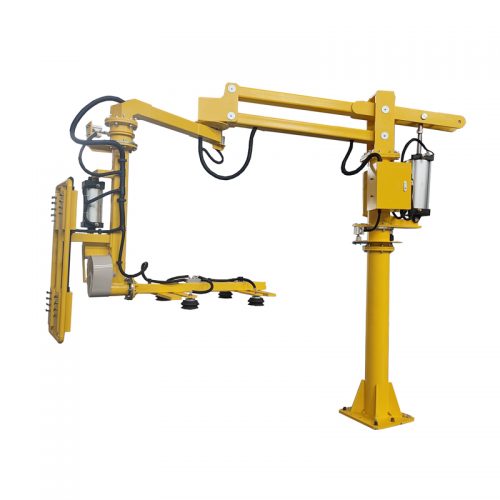Assisted lifting manipulators, commonly known as power manipulators, balance cranes or zero-gravity arms in the industrial field. The core function of this type of equipment is to assist operators to lift, carry and position heavy objects or tools safely and labor-savingly, thereby greatly improving the ergonomics of work, improving efficiency and safety.
They are between traditional lifting equipment (such as electric hoists) and fully automatic industrial robots, aiming to achieve human-machine collaboration, combining human flexibility and judgment with the power and stability of machines.
The core principle of the assisted lifting manipulator is to offset the weight of the load, making it “weightless” in the hands of the operator, and the operator only needs to apply a small force to guide its movement.
Main types and their working principles:
1. Pneumatic power manipulator:
Principle: The most common type. Compressed air is used to generate an upward force in the cylinder to accurately balance the weight of the load (including fixtures and workpieces). The operator controls the air pressure through the pneumatic valve on the handle to achieve rising, falling and maintaining balance.
Features: Smooth operation, sensitive response, natural explosion-proof characteristics (no electric sparks), suitable for use in humid, dusty or flammable and explosive environments.
2. Electric servo-assisted manipulator:
Principle: More advanced and intelligent. High-precision servo motors and force sensors are used to sense the tiny force applied by the operator and the weight of the load in real time, and accurately drive the motor to generate compensation force.
Features: Higher precision, finer control, more complex motion modes (such as path guidance, anti-swing, virtual force field), easy to integrate with more advanced automation systems.
3. Spring Balancer:
Principle: Use the elastic force of a mechanical spring to balance the weight of the load.
Features: Simple structure, no external energy (such as compressed air or electricity), but usually suitable for tools or light workpieces with relatively fixed load weight and little change. Its “zero gravity” effect is not as ideal as pneumatic or electric servo systems, and is usually not classified as a “robot arm” in the strict sense.
Auxiliary lifting robot arms are widely used in industrial fields with high requirements for material handling accuracy, safety and ergonomics:
1. Loading and unloading of machine tools: Accurately loading or unloading heavy objects such as castings, molds, and processed parts from machine tools.
2. Automobile and parts manufacturing: Assembly, handling and alignment of parts such as engines, gearboxes, doors, axles, and tires.
3. Mold handling and replacement: Safely and quickly handle and replace heavy molds in injection molding, stamping, die-casting and other workshops.
4. Precision assembly line: Assembly operations that require precise alignment of electronic products, medical devices, aerospace components, etc.
5. Glass and plate handling: Non-destructive handling and stacking of fragile or bulky flat workpieces such as large glass, metal plates, and wooden boards.
6. Tool operation assistance: Assist operators to use heavy handheld tools such as tightening guns, grinders, drilling machines, dispensing guns, welding guns, etc. for a long time to reduce fatigue and improve operation quality.
7. Narrow space or obstacle area: The folding arm design enables it to bypass obstacles and perform material operations in complex environments.
8. Packaging/palletizing assistance at the end of the production line: Cartoning and stacking of finished products.
